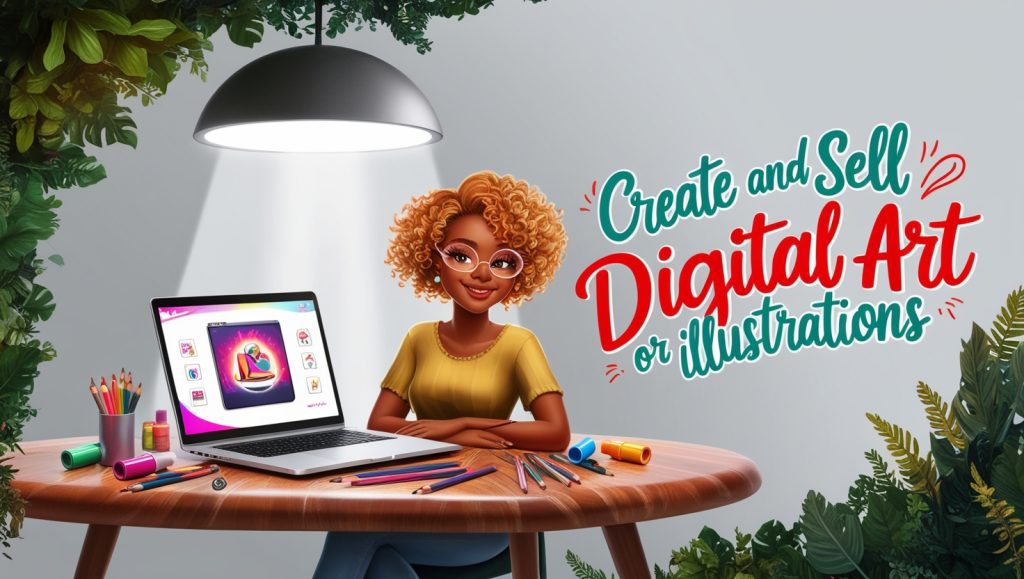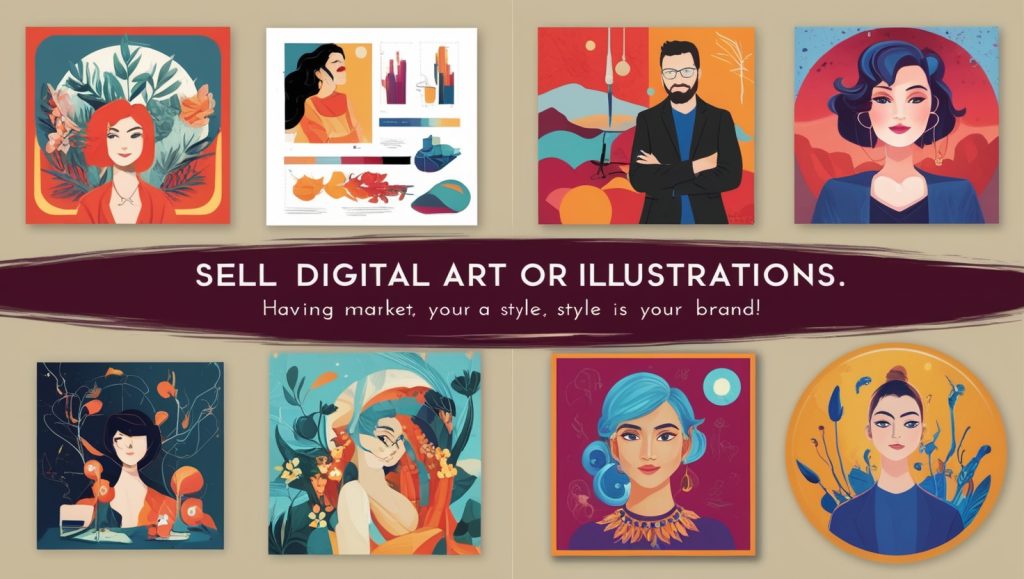Digital art has become a cornerstone of contemporary creativity, merging technology with traditional artistic practices. The ease of access to digital tools and platforms has empowered artists globally, enabling them to create stunning visuals and reach audiences far beyond their geographic boundaries. This comprehensive guide explores the journey of digital art creation, from conceptualization to selling your work in today’s dynamic digital marketplace.

The Evolution of Digital Art
Early Beginnings
Digital art’s roots can be traced back to the 1960s when computers were first used to create simple geometric patterns and basic visual designs. Artists like Frieder Nake and Vera Molnár were pioneers, using early computer programs to explore the intersection of art and technology.
The Rise of Personal Computing
The 1980s saw a significant shift with the advent of personal computers and software like Adobe Photoshop, which revolutionized the way art could be created and manipulated. This era also saw the rise of digital graphic design as a profession, with artists now able to create intricate designs, illustrations, and animations directly on their computers.
Modern Digital Art
Today, digital art encompasses many forms, from digital painting and 3D modeling to virtual reality and generative art. The tools available are more powerful and accessible than ever, allowing artists to push the boundaries of creativity.
Tools and Techniques in Digital Art Creation
Software for Digital Art
The choice of software is crucial in digital art creation. Here are some of the most popular programs used by digital artists:
- Adobe Photoshop: The industry standard for digital painting and photo manipulation, Photoshop offers a vast array of tools and features that cater to beginners and professionals.
- Corel Painter: Known for its realistic brushstrokes and textures, Corel Painter is favored by artists who want to emulate traditional painting techniques digitally.
- Procreate: A favorite among iPad users, Procreate is a powerful and intuitive app that offers a seamless drawing experience with various brushes and effects.
- Blender: For 3D modeling and animation, Blender is an open-source program that rivals many paid alternatives. It’s widely used in the creation of 3D art, animations, and even video game assets.
- Krita: An open-source painting program, Krita is praised for its user-friendly interface and powerful features, making it an excellent choice for illustrators.
Hardware Essentials
Creating digital art requires not just the right software but also suitable hardware:
- Graphics Tablets: Devices like Wacom Cintiq and Huion Kamvas allow for precise control with a stylus, making them essential tools for serious digital artists.
- iPads: The iPad Pro, combined with the Apple Pencil, offers a highly portable and capable platform for digital art creation, particularly with apps like Procreate.
- High-Performance Computers: A powerful PC or Mac is necessary for running demanding software, especially for tasks like 3D rendering or working with large files in Photoshop.
Digital Art Techniques
Digital art techniques vary widely depending on the style and medium:
- Layering: One of the key advantages of digital art is the ability to use layers, which allows artists to separate different elements of their work and make non-destructive changes.
- Brush Customization: Most digital art software allows for extensive customization of brushes, enabling artists to replicate traditional media like oils, watercolors, and charcoal.
- Blending Modes: Digital tools provide various blending modes that can change how layers interact with each other, offering unique creative possibilities.
- Filters and Effects: Digital art software often includes a range of filters and effects that can be applied to images to achieve different textures, lighting effects, and color adjustments.

Creating Digital Art: A Step-by-Step Process
1. Concept Development
Every piece of art starts with an idea. This could be a concept sketch, a mood board, or a clear vision in your mind. The conceptual stage is crucial as it defines the direction and style of the artwork.
2. Sketching
Begin by sketching your idea. Whether you use a traditional method or a digital tool, sketching helps you to visualize the composition, layout, and perspective. Many artists prefer digital sketching because it offers flexibility in making adjustments and experimenting with different elements.
3. Blocking in Colors
After finalizing the sketch, move on to blocking in the main colors. This step helps in setting the overall mood and tone of the piece. Digital tools allow you to experiment with color schemes easily, offering the option to adjust hues, saturation, and brightness with just a few clicks.
4. Adding Details and Refinement
This stage involves refining the artwork by adding details and textures. Artists often work in layers, allowing them to focus on specific parts of the image without affecting the rest. This step is where the artwork begins to come to life, with careful attention to light, shadow, and texture.
5. Final Touches
The final stage of the digital art creation process involves adding finishing touches. This could include adjusting the contrast, applying filters, adding text or signatures, and ensuring that every detail is polished to perfection. Many artists also use this stage to step back and evaluate the piece as a whole, making any necessary adjustments before declaring it complete.

Selling Digital Art: Platforms and Strategies
Online Marketplaces
Online marketplaces are the most accessible way for digital artists to sell their work. These platforms provide a ready-made audience and take care of the transactional side, allowing artists to focus on creating.
- Etsy: Known for handmade and unique items, Etsy has become a popular platform for selling digital downloads such as prints, illustrations, and designs.
- Gumroad: Gumroad allows artists to sell digital products directly to consumers, offering a simple and effective platform for monetizing digital art.
- Redbubble: Redbubble is a print-on-demand service where artists can upload their designs to be printed on a wide variety of products, from posters to apparel.
Print-on-Demand Services
Print-on-demand (POD) services offer artists a way to monetize their designs without having to manage inventory or shipping:
- Society6: Society6 allows artists to sell their designs on products like home decor, clothing, and accessories. Artists receive a commission on each sale.
- Teespring: Teespring is another POD platform, focusing primarily on custom apparel and merchandise. It allows artists to create and sell their designs without any upfront costs.
Non-Fungible Tokens (NFTs)
The rise of blockchain technology has introduced a new avenue for selling digital art through NFTs. Non-fungible tokens provide a way to verify the ownership and authenticity of digital artworks, making them highly desirable to collectors.
- OpenSea: OpenSea is one of the largest NFT marketplaces, allowing artists to mint and sell their digital art as NFTs.
- Rarible: Rarible is a community-driven NFT marketplace that offers artists the ability to mint and sell their work directly to collectors.
Social Media and Personal Websites
Building a presence on social media is crucial for any digital artist looking to sell their work:
- Instagram: Instagram is a visual platform perfect for showcasing your digital art. Regular posting, engaging with followers, and using relevant hashtags can significantly increase your visibility.
- Twitter: Twitter is an excellent platform for networking with other artists, sharing your work, and participating in art challenges.
- Personal Website: A personal website or online portfolio serves as a central hub for your work. It provides a professional appearance and allows for direct sales and commissions.
Commissions and Freelance Work
Many digital artists supplement their income by offering commissions or working as freelancers:
- Fiverr: Fiverr is a platform where artists can offer their services for a wide range of projects, from custom illustrations to logo design.
- Upwork: Upwork connects freelancers with clients looking for specific services. Digital artists can find a variety of projects, including illustration, graphic design, and more.
Strategies for Success in Selling Digital Art
Develop a Unique Style
In a crowded market, having a distinct style is essential. Your style is your brand, and it’s what will attract clients and collectors. Experiment with different techniques, color schemes, and subjects until you find a style that resonates with you and your audience.
Build a Strong Portfolio
A well-curated portfolio is key to attracting clients and buyers. Showcase your best work, and make sure your portfolio is easy to navigate. Including a variety of projects can help appeal to a broader audience.
Pricing Your Work
Pricing digital art can be challenging. It’s important to research the market and consider the time and effort you’ve invested in each piece. Be flexible and open to adjusting your prices based on demand and feedback.
Engage with Your Audience
Building a community around your work can significantly boost your sales. Engage with your followers on social media, participate in online art communities, and be responsive to comments and messages. This interaction not only increases your visibility but also builds a loyal customer base.
Continuous Learning
The digital art world is constantly evolving. Stay updated with new tools, techniques, and trends to keep your work fresh and relevant. Participating in online courses, webinars, and workshops can also help you improve your skills and stay competitive.
Case Studies: Successful Digital Artists
Beeple (Mike Winkelmann)
Beeple is a digital artist who became widely known after selling an NFT of his work for $69 million. His success showcases the potential of digital
art in the new age of blockchain technology and NFTs.
Loish (Lois van Baarle)
Loish is a Dutch digital artist known for her unique, illustrative style. With a large following on social media, she successfully sells her work through various platforms, including prints, books, and tutorials.
Ross Tran (RossDraws)
Ross Tran is a digital artist and YouTuber known for his vibrant character designs and fantasy illustrations. He has built a strong online presence, with income streams ranging from print sales to Patreon subscriptions and sponsorships.
Future Trends in Digital Art
The Rise of AI in Art
Artificial Intelligence (AI) is beginning to play a significant role in digital art. Tools like DeepArt and AI-based design programs are offering artists new ways to create and experiment with their work. While some fear that AI could replace human creativity, many see it as a tool to enhance and inspire new forms of art.
Virtual and Augmented Reality
Virtual Reality (VR) and Augmented Reality (AR) are opening up new dimensions for digital artists. VR platforms like Tilt Brush allow artists to paint in a three-dimensional space, while AR can bring digital art into the physical world through interactive installations and experiences.
Sustainability and Digital Art
As the environmental impact of NFTs has come under scrutiny, the digital art community is increasingly focused on sustainability. Platforms and artists are exploring eco-friendly alternatives and advocating for greener practices in the industry.
Conclusion
Digital art is not just a fleeting trend; it’s a fundamental shift in the way art is created, shared, and monetized. The accessibility of digital tools has democratized art, allowing anyone with a computer or tablet to become an artist. Selling digital art has never been easier, with a plethora of platforms and methods available to artists at all levels. By honing your craft, developing a unique style, and leveraging the right strategies, you can turn your passion for digital art into a thriving career. As technology continues to evolve, the possibilities for digital artists are limitless, making now the perfect time to explore this exciting field.